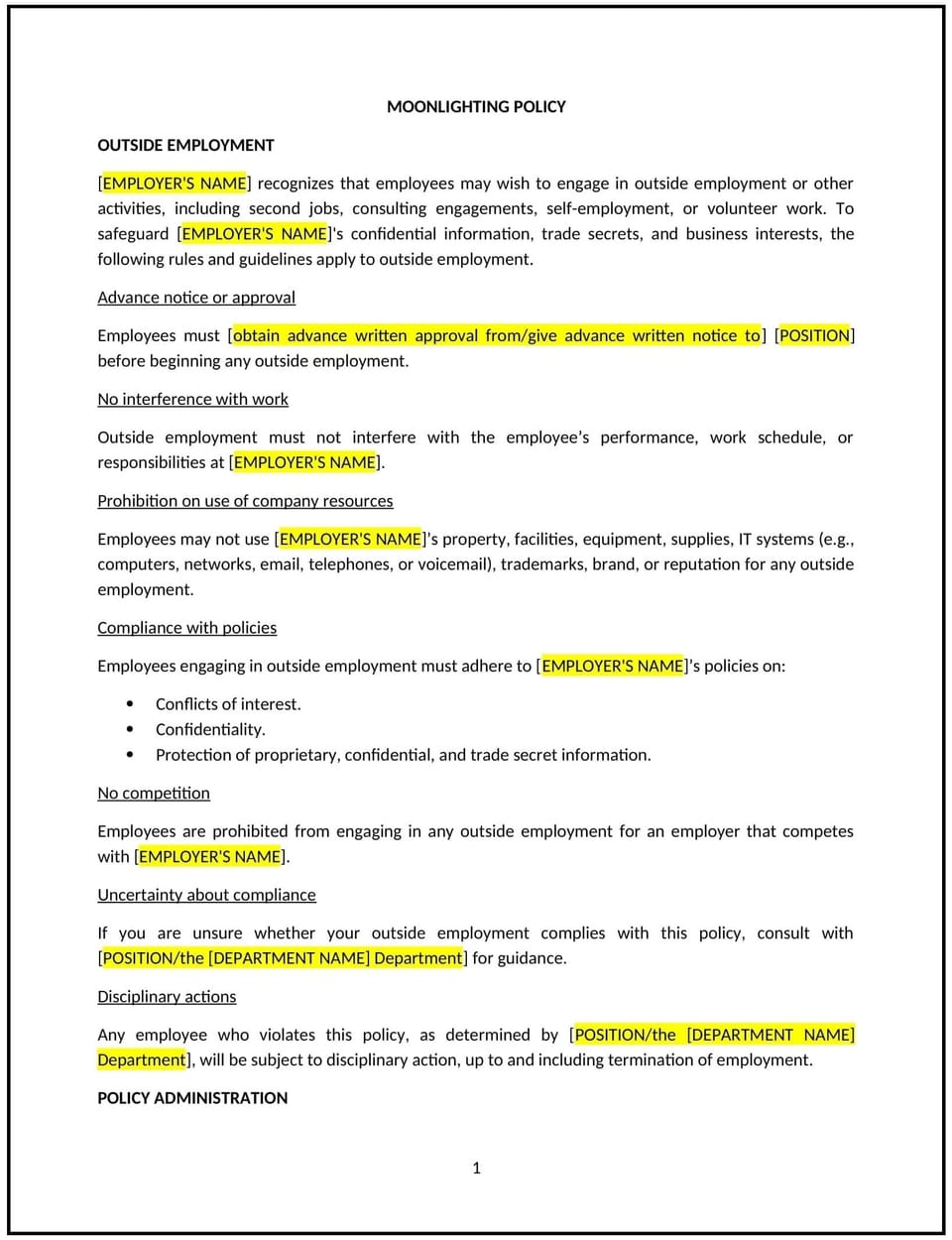Moonlighting policy (Utah): Free template

Moonlighting policy (Utah)
This moonlighting policy is designed to help Utah businesses establish guidelines for employees who work additional jobs outside their primary employment. It outlines procedures for disclosing secondary employment, addressing conflicts of interest, and maintaining productivity.
By adopting this policy, businesses can protect their interests, ensure employee focus, and align with general best practices for managing secondary employment.
How to use this moonlighting policy (Utah)
- Define moonlighting: Explain what constitutes moonlighting, such as working a second job or freelance work.
- Establish disclosure requirements: Provide steps for employees to disclose secondary employment to the business.
- Address conflicts of interest: Specify that secondary employment must not conflict with the employee’s primary job responsibilities or the business’s interests.
- Set productivity expectations: Clarify that moonlighting must not negatively impact the employee’s performance or attendance.
- Enforce consequences: Outline disciplinary actions for policy violations, such as warnings or termination.
- Train employees: Educate employees on the policy and their responsibilities regarding secondary employment.
- Review and update: Assess the policy annually to ensure it aligns with evolving business needs and workplace trends.
Benefits of using this moonlighting policy (Utah)
This policy offers several advantages for Utah businesses:
- Protects business interests: Ensures secondary employment does not conflict with the employee’s primary job responsibilities.
- Maintains productivity: Reduces the risk of moonlighting negatively impacting employee performance or attendance.
- Aligns with best practices: Provides a structured approach to managing secondary employment.
- Reduces legal risks: Minimizes the potential for conflicts of interest or disputes related to moonlighting.
- Enhances transparency: Encourages open communication about secondary employment.
Tips for using this moonlighting policy (Utah)
- Communicate the policy: Share the policy with employees and include it in the employee handbook.
- Provide training: Educate employees on the policy and their responsibilities regarding secondary employment.
- Monitor compliance: Regularly review employee disclosures and performance to ensure adherence to the policy.
- Address issues promptly: Take corrective action if moonlighting negatively impacts productivity or creates conflicts of interest.
- Update regularly: Assess the policy annually to ensure it aligns with evolving business needs and workplace trends.
Q: How does this policy benefit businesses?
A: By managing moonlighting effectively, businesses can protect their interests, maintain productivity, and reduce legal risks.
Q: What types of secondary employment are typically allowed?
A: Secondary employment is generally allowed if it does not conflict with the employee’s primary job responsibilities or the business’s interests.
Q: How can businesses ensure moonlighting does not impact productivity?
A: Businesses should set clear expectations, monitor employee performance, and address issues promptly.
Q: What should businesses do if an employee violates the policy?
A: Businesses should follow the disciplinary actions outlined in the policy, such as warnings or termination.
Q: How often should businesses review this policy?
A: Businesses should review the policy annually or as needed to ensure it aligns with evolving business needs and workplace trends.
This article contains general legal information and does not contain legal advice. Cobrief is not a law firm or a substitute for an attorney or law firm. The law is complex and changes often. For legal advice, please ask a lawyer.


